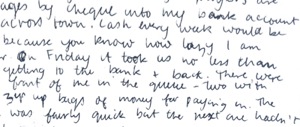Journal of Forensic Document Examination – 2008 Issue
Volume 19
Table of Contents and Abstracts [click titles to open and close abstracts]
Emmanuelle Sciacca, Marie-Blanche Langlois-Peters, JeanClaude Gilhodes, Pierre Margot, Jean-Luc Velay
ABSTRACT: Handwriting is characterized by a certain intrinsic variability. However, this within-subject variability (WSV) requires quantification. Under usual conditions (UC), the WSV is likely low compared to the between subject variability (BSV), thus requiring a small number of samples in order to determine the identity of the writer. However, the WSV may be greater under unusual conditions (UnC), for instance in an uncomfortable position, thereby reaching values closer to BSV. This would require the examination of a greater number of samples. Here we aimed to investigate whether individual variability changes with writing conditions and measure the number of samples required to identify a particular writer.

Twelve subjects were asked to write two word sets 32 times in upper and 32 times in lower case, under two different conditions: sitting on a chair and writing on a table (UC) and kneeling and writing on the floor (UnC). Words were written on a pen tablet, normalized in space and time and then averaged. We then measured the variance from sample 2 to sample 32 under both conditions, as well as the number of samples necessary to reach a stable value corresponding to the correct variance. Results showed only a slight increase in WSV under UnC. Under both conditions, the variability was correctly assessed with 8 to 10 writing samples. The value of BSV was twice that of WSV for lowercase wheras for uppercase letters the BSV/WSV ratio was equal to 1.
James G. Phillips, Rowan P. Ogeil, Doug Rogers
ABSTRACT: Alcohol abuse can complicate an evaluation of handwriting for forensic document examiners. A number of characteristics have been reported to change with alcohol consumption (e.g. spacing, alignment, character height, word length). Twenty participants were asked to write a standard letter before and after consumption of a dose of vodka and orange juice that produced a peak blood alcohol concentration of 0.051%. Analysis of spacing, word lengths and heights and individual stroke lengths and slopes suggested that there can be differences in word height and width, but these effects may be reduced in people who are alcohol dependent.
Russell Conduit
ABSTRACT: Despite several lines of research suggesting psychomotor impairment during sleep deprivation, no studies to date have shown significant changes in the quality of handwriting under sleep deprivation. 32 participants were asked to complete a 15 minute writing task involving repetitive writing of words, letters and their signature, along with a standard letter.

This task was done after 24 hours of sleep deprivation and after a normal night’s sleep, spaced one week apart with the order counterbalanced across participants. Sleep deprivation was associated with statistically significant increases in the amount of space used when writing. Although consistent with broader studies showing a decline in motor function during sleep deprivation, these results were not consistent with a small group of previous studies of handwriting during sleep deprivation, This may be due to task differences or possibly issues related to methodology. It was concluded that sleep deprivation induced increases in writing space may be due to progressive disturbances in cortical and subcortical motor and attention networks.
Heidi H. Harralson, Hans-Leo Teulings, Becky G. Farley
ABSTRACT: Little empirical research exists on differential identification of handwriting distortion caused by the writer’s movement disorder and forgeries of such a movement disorder. In this study, 12 participants forged handwriting produced by a healthy writer, a writer with clinically diagnosed essential tremor (ET), and a writer with clinically diagnosed Parkinson’s disease (PD). The handwritings were recorded on a digitizing tablet using NeuroScript MovAlyzeR software. Total duration, total absolute size, average absolute velocity, and average pen pressure were estimated per writing trial. Analysis of variance (ANOVA) and post-hoc tests (t-test, Tukey’s HSD) showed significant differences between experimental subjects’ normal writing and their forgery of three models (healthy, ET, PD) in the movement domain (duration, velocity). When comparing subects’ forgery tasks with each of the models, significant differences were found in duration and velocity. In addition, frequency spectrum analysis showed smaller components at lower frequencies when performing forgeries in comparison to genuine writings. Findings support kinematic differences between writing by persons with movement disorders and writing by persons forging movement disorders.
JFDE Issues
Issues from 2014 through the current issue are found at JFDE.org.
- Volume 26, 2016
- Volume 23, 2013
- Volume 22, 2012
- Volume 21, 2011
- Volume 20, 2009-2010
- Volume 19, 2008
- Volume 18, 2007
- Other Back Issues
To purchase back issues or for more information, contact us via email.
